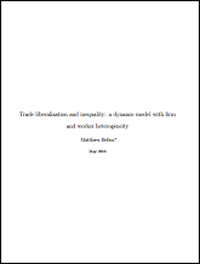A vast literature demonstrates that trade liberalization is associated with higher wage inequality. Nearly the entire literature considers comparative statics or steady states, which ignore dynamics and of necessity feature monotonic changes. I address these limitations by developing a micro-founded model that emphasizes the dynamics of reallocation between heterogeneous firms and workers in the presence of costly labor adjustments. Trade liberalization provides firms both new export markets and new sources of competition. Expanding high-paying firms increase wages to recruit better workers faster. Workers at firms threatened by competition accept wage cuts to delay their employers’ exit and keep their job. This provides novel implications for both aggregate and within-firm inequality across a distribution of firm types. I show that key mechanisms of the model are consistent with a range of facts using matched firm-worker data from France. Results from the calibrated model suggest an overshooting of inequality on the path to a new steady state. This is consistent with evidence based on an event study of recent liberalization episodes. Inequality appears to peak about six years after liberalization, with one-fourth of the overshooting disappearing in the following ten years.
Por: Bellon, Matthieu.




